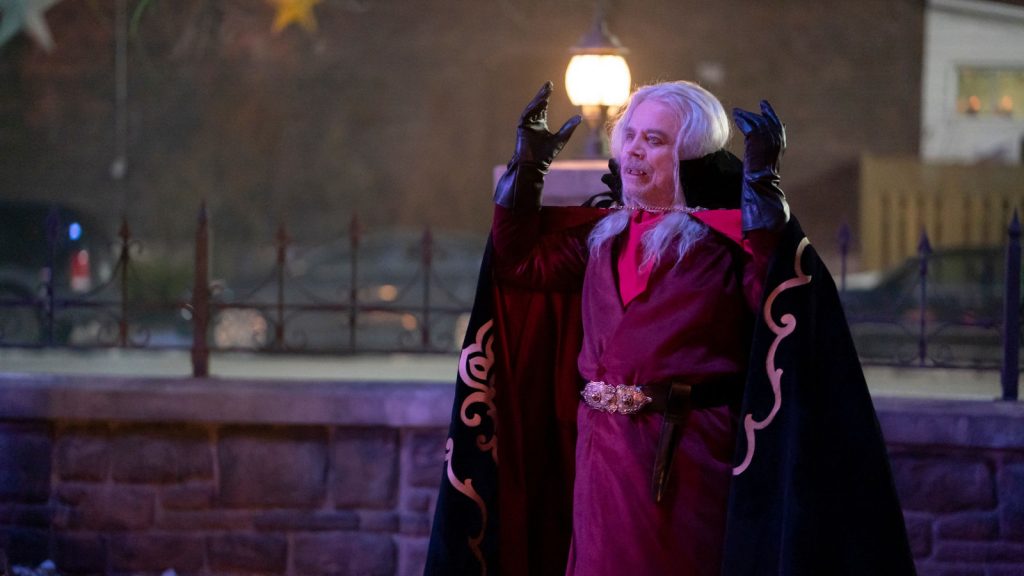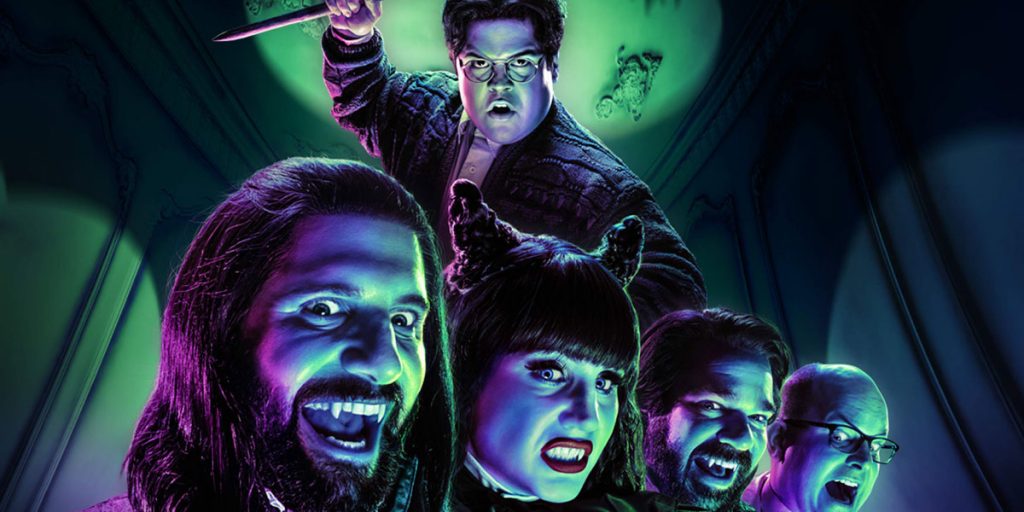After becoming a comedy cult classic, What We Do in The Shadows has successfully made its way from the big screen to the small.
What We Do in the Shadows originally began its journey to the screen 15 years ago, with the short film What We do in the Shadows: Interviews with some Vampires directed by and starring Taika Waititi and Jemaine Clement as Viago and Vulvus (later known as Vladislav), with Jonny Brugh, Cori Gonzalez-Macuer and Stu Rutherford as Nick and Stu. The short is comprised of interview-style clips of the three vampire flatmates Viago, Vulvis and Decon (Jonny Brugh). Filmed in the style of a documentary, the film follows the vampires through their daily lives, documenting arguments over chores and the flatmates night out on the town. The short was later developed into feature film What We do in the Shadows, written and directed by Waititi and Clement and shown in 2014 at the Sundance Film Festival. The 86 minutes long comedy-mocumentary follows four vampires – Viago, Vladislav, Deacon, and Petyr, an 8,000-year-old vampire who resembles Count Orlok, played by Ben Fransham – through their nightly lives, or should I say deaths. The feature film is loosely based on the original short film, although the short was more sit-down-style-interview-oriented, as opposed to wider mocumentary style of the feature film and series.
The movie consists largely of improv comedy, loosely based around a script that only Waititi and Clement knew in depth, giving the film a more natural and authentic documentary feel. The character Stu (Stu Rutherford), who features in both the original short film and the later feature, was not an actor but just a friend of Waititi and Clement, who thought that his involvement would ground the film. As an expansion of the short, keeping its original characters gives What We do in the Shadows a level of depth that it benefits from, making the dynamic between the characters seem much more believable. The cast, writers and directors clearly care about the film: it is a passion project that was 9 years in the making. The story, character, and comedy in the What We Do in the Shadows are all elements that go hand in hand, and the reason this works so well is because the actors as so acquainted with the characters that they are playing.
In the film and series, all the characters have a level of awkwardness in front of the camera ‘crew’ which further adds to the comedy element of both. In the series, we see the characters engage with the mockumentary crew more than we do in the film, and this wholly dedicates the show to the mocumentary style putting it among other much-loved sitcoms such as The Office and Parks and Recreation. Waititi and Clement subvert our expectations concerning vampire films, taking tropes that we see in films like Twilight and twisting them. For example, all the vampires have powers but sometimes they are not very good at using them, which often leads to these powers becoming a disadvantage. It becomes a running joke in the film that Vladislav has the power to transform into animals, but when he does so he can never get the face right. What We Do in the Shadows takes elements that are generally used to make vampires cool, intriguing, and attractive and uses them to do the opposite, resulting in both a great comedy and an exploration of vampires in pop culture.

The overall juxtaposition of vampires leading unbelievably mundane lives is where What We Do in the Shadows draws its main element of comedy from, not only for the vampires themselves, but for the world around them and the reactions of the people in it. The concept of vampires trying to fit in with humans opposes the tropes of isolation we often see in older Vampire films like Interview with The Vampire, and the mysterious stranger that we see in more recent films such as Twilight. This results in Waititi and Clement making a film about vampires that makes them appear unbelievably mundane. It feels like it is a mocumentary about the trials and tribulations of existing, that just so happens to be about vampires.
The tv series understands the humour of the feature film, and why all the elements worked so well together. The show follows a similar formula to the film, with slight alterations. It stars Kayvan Novak as Nandor the relentless, a 757-year-old vampire and former soldier of the Ottoman empire, with Harvey Guillen as his human familiar Guillermo De la Cruz. Alongside him are Matt Berry and Natasia Demetriou as vampire couple Lazlo and Nadja, with Mark Proksch as an energy vampire called Colin Robinson, and cameos from names such as Bernie Feldstein, Nick Kroll, Tilda Swinton, Dave Bautista, and Mark Hamill.
The series follows a similar basis, along with the absence of a typical comedy laugh track and any background music that gives it an organic feel as if it were a real documentary. While the series could have ended up been nothing more than a lazy copy of the film, it avoids this by expanding the ideas that we see in the film. Introducing new characters such as Colin Robinson (Mark Proksch), an energy vampire who feeds on the negative energy that he creates, and setting the show in Staten Island, New York, allows What We Do in the Shadows to develop a wider story introducing a range of new characters and creatures such as ghosts, zombies and witches.
While the show does have moments and jokes that are similar to what we see in the film, these moments are overshadowed by the new elements of the series. It keeps the same tone as the 2014 film, with references to other vampire films such as The Lost Boys, Twilight and Interview with the Vampire, and still satirises vampires, not by making them obnoxious but by putting them in incredibly boring situations that you wouldn’t expect to see vampires in. The show carries on the movie’s take on old vampires trying to fit in with the modern world at various points throughout, especially in the first season, where the Staten Island vampires are tasked with conquering the ‘new world’ by the Baron Afanas (Doug Jones), a vampire who believes that they should rule the world. The task leads to the four vampires and Guillermo attending a local city council meeting in an attempt to take over the city, a situation that plays by the original comedy of focusing on the mundane elements of these vampires’ lives as while they are powerful immortal beings they still have to abide by the law. Another reason the series works so well is that the characters all have a level of complexity to them and feel like fully rounded people, or vampires. Having all the main vampire characters be European, not American allows far more comedy, emphasising how out of touch they are with not only the modern world but with America.

A large majority of the What We Do in the Shadows series is built around tasks that are very human domestic disputes, developing Waititi and Clement’s original concept of showing that, if vampires were to exist, they would not be all the glamorous things we see in other films. To quote Waititi’s character from the original What We do in the Shadows: Interviews with some Vampires, ‘being undead is the same as being alive, except that every part of you is dead.’ Both the films and series give us a more realistic insight into what the world of vampires would actually be like.
Waititi and Clement manage to write a comedy about vampires that is quick witted and truly funny without feeling repetitive or relying on being condescending or shallow towards other vampire films. They take relatable ordinary moments, such as living with flatmates or grocery shopping, and place these supernatural creatures in them creating one of the funniest sitcoms to ever be on TV.

